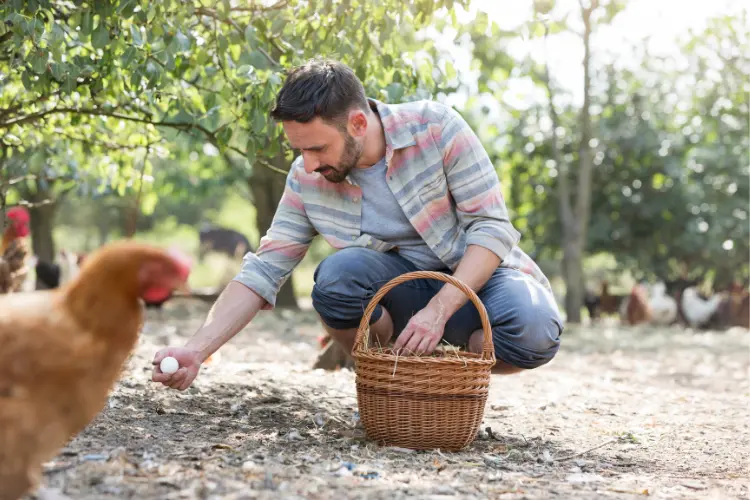How to Collect Chicken Eggs: Top Tips for Poultry Owners
Keeping chickens in your backyard is a beautiful experience, and one of the best parts is gathering fresh eggs. But, sometimes, collecting those eggs can be a bit tricky and frustrating. You might find dirty or broken eggs, and that’s no fun. Don’t worry! In this guide on how to collect chicken eggs, we’ve made it super simple to understand.
We’ll tackle the common problems and show you easy solutions to make egg collecting a smooth and enjoyable task. Let’s get started and make egg gathering a breeze.
How Frequently Do Chickens Produce Eggs?
When knowing how to collect chicken eggs, you should know how often your chicken lays. A healthy hen in her prime laying period can produce an egg nearly every 24 to 27 hours, equating to about 5 to 7 eggs per week. However, this frequency can vary widely. Some breeds, known for their prolific egg-laying abilities, might consistently lay one egg per day, while others, especially those bred for meat or ornamental purposes, may lay fewer eggs.
Daylight exposure also affects the laying cycle, with longer daylight hours promoting higher egg production. As hens age, their egg production gradually decreases. Stress, diet, and living conditions can also impact a hen’s laying frequency.
Read also: How Many Eggs Does A Chicken Lay A Day
What Are the Signs That a Hen Is Ready to Lay?

Exploring the Nesting Boxes
One of the most apparent signs that a hen is ready to lay eggs is her interest in the nesting boxes. As the egg-laying time approaches, hens often explore nesting areas, and some may even try sitting in the boxes. To encourage this behavior, you can place a few artificial eggs in the nesting boxes, signaling your hens that it’s time to lay.
Changes in Comb and Wattle
The comb, located on the top of a chicken’s head, and the wattles, the fleshy appendages beneath their beak, can provide valuable clues. As a hen approaches laying an egg, you’ll notice that her comb and wattles may enlarge and become redder. These comb and wattle changes are attributed to increased blood flow to these areas as the hen’s body prepares for egg production.
Squatting Behavior
When hens start to exhibit a submissive squatting posture when you approach them, it strongly indicates that egg-laying is imminent. This behavior mimics a hen’s position when a rooster mounts her for breeding. The hen drops into a crouching position, making it easier for the rooster to mate. However, without a rooster, this behavior signals the hen’s readiness to lay eggs.
Increased Appetite
A hen’s diet plays a crucial role in egg production. While young chicks are typically fed a high-protein chick starter feed, laying hens require a different diet. Layer feed contains extra calcium and is essential for producing eggs with strong shells.
As a hen approaches the laying stage, her appetite often increases. This heightened appetite is her body’s way of preparing to form and lay eggs. Adequate calcium intake is vital to prevent eggs with soft shells.
Singing and Squawking
As egg-laying becomes imminent, hens often become more vocal. They may start making loud squawking noises, which can sometimes be referred to as an “egg song.” This behavior is their way of signaling the upcoming egg-laying event. Some hens even continue to vocalize before and after laying an egg, serving as an egg alarm to alert you to their productivity.
Nervous and Skittish Behavior
Hens may appear more nervous and skittish than usual as they search for the perfect spot to lay their eggs. This behavior results from their instinctual need to find a safe and secluded location for egg-laying. They become more vigilant in anticipation of the egg-laying process.
Read also: When Do Chickens Start Laying Eggs?
Common Challenges in Collecting Eggs and How to Solve These

Hean Eating Their Own Eggs
When hens start eating their own eggs, it can be a frustrating problem. This behavior often stems from a lack of essential nutrients in their diet, particularly calcium, or it could be due to accidental discovery when a hen breaks an egg.
To prevent this, ensure your chickens have a balanced, calcium-rich diet. Providing a calcium supplement, like an oyster shell, separately from their regular feed allows hens to consume it as needed.
Additionally, collect eggs frequently to minimize the opportunities for hens to peck at them. Darkening the nesting boxes can also help, making the eggs less visible and less tempting for the hens.
Read also: How to Stop Chickens From Eating Eggs: Effective Strategies
Predator and Pest
Predators, such as snakes, rats, and raccoons, and pests like mites and lice, can pose significant challenges in egg collection. These unwelcome visitors not only steal eggs but can also harm the health of your flock.
To combat this, reinforce your coop and nesting boxes to make them predator-proof. You can use hardware cloth, as it’s more durable and offers better protection.
Regularly inspect and clean the coop to keep pests at bay, and consider using natural deterrents or pest control methods that are safe for chickens.
Eggs Outisde in Nesting Boxes
Sometimes, chickens may choose to lay their eggs outside of the designated nesting boxes, which can lead to eggs getting dirty, lost, or damaged. To encourage hens to use nesting boxes, ensure they are clean, comfortable, and located in the coop’s quiet, dark part.
Additionally, adding fake eggs or golf balls in the nesting boxes can also guide hens to lay their eggs in the desired spot. If certain hens consistently lay eggs elsewhere, observing their behavior might provide clues to adjust the environment to better suit their preferences.
Broody Hens
A broody hen wants to hatch eggs and may become aggressive or refuse to leave the nesting box, making egg collection difficult. To discourage broodiness, remove eggs promptly and consistently.
If a hen remains broody, isolate her in a well-lit, comfortable area away from the nesting boxes until she returns to normal behavior. Ensuring the coop has adequate ventilation and is not overly warm can also help prevent broodiness, as excessively warm conditions can trigger this instinct.
Egg Breakage or Cracking
Egg breakage or cracking can lead to loss and attract unwanted pests or lead to hens eating their own eggs. To minimize this, provide plenty of nesting material like straw or shavings to cushion the eggs as they are laid. Ensure that the nesting boxes are not overcrowded and have enough space for all the hens. Collecting eggs frequently can also reduce the likelihood of breakage due to hens stepping on them.
Guidelines for Cleaning and Storing Chicken Eggs

1. Collect Eggs Gently
When collecting eggs from your chickens, handle them gently to prevent breakage. Use clean, coated wire baskets or plastic containers for collection to avoid rust stains on the eggs, which can be challenging to clean.
2. Don’t Stack Eggs Too High
Avoid stacking eggs too high when collecting. If using baskets, do not stack more than five layers deep. If using plastic flats, limit stacking to no more than six flats. Stacking eggs too high can increase the risk of breakage.
3. Avoid Rapid Cooling
Never cool eggs rapidly before cleaning. The eggshell can contract during rapid cooling, pulling any dirt or bacteria on the surface deep through the pores. Try to keep the temperature relatively constant first until you’re ready to wash the eggs.
4. Wash Eggs Promptly
It’s essential to wash eggs as soon as you collect them. This helps limit contamination and prevents a loss in interior quality.
5. Use Proper Water Temperature
When washing eggs, use water at 90°F or higher and at least 20°F greater than the egg’s temperature. Use an approved cleaning compound and then rinse with slightly warmer water using an approved sanitizer (50–200 ppm). This causes the egg contents to sweat and pushes dirt away from the pores. Never let eggs sit submerged in water.
6. Dry and Cool Quickly
After washing, dry and cool the eggs promptly. Store them with the large end up at temperatures between 40–45°F and 70% relative humidity. Eggs left at room temperature (65°F or higher) can degrade by one grade per day. Eggs should maintain a Grade A quality for at least six weeks.
7. Fertile Eggs and Temperature
If you’re dealing with fertile eggs, keep them at a temperature below 85°F. Prolonged exposure to higher temperatures can develop germinal disc (embryo) and visible blood vessels in the embryo.
8. Frequent Collection in Hot Weather
In hot weather, collect eggs at least twice a day. The first collection should be before 10 a.m. Start by gathering eggs with no chickens on them. Carefully lift hens sitting in nests, remove any eggs, and return them to their roosts. Leaving eggs in the nest for longer periods can accumulate dirt and breakage.
Maintaining cleanliness and following these guidelines for collecting, cleaning, and storing chicken eggs ensures you’ll have fresh, high-quality eggs for your culinary creations. By taking these precautions, you can enjoy your eggs with confidence, whether they come from your backyard or a local source.
How to Collect Chicken Eggs Summary
Collecting chicken eggs is not just a daily chore but a rewarding and enjoyable aspect of backyard poultry keeping. Following the top tips outlined in this guide, poultry owners can create a smoother and more efficient egg collection process while ensuring the freshness and quality of their eggs.
Whether you’re a beginner or an experienced chicken enthusiast, these practices will help you make the most of your feathered friends, fostering a stronger connection with your flock and the satisfaction of serving farm-fresh eggs on your table.




